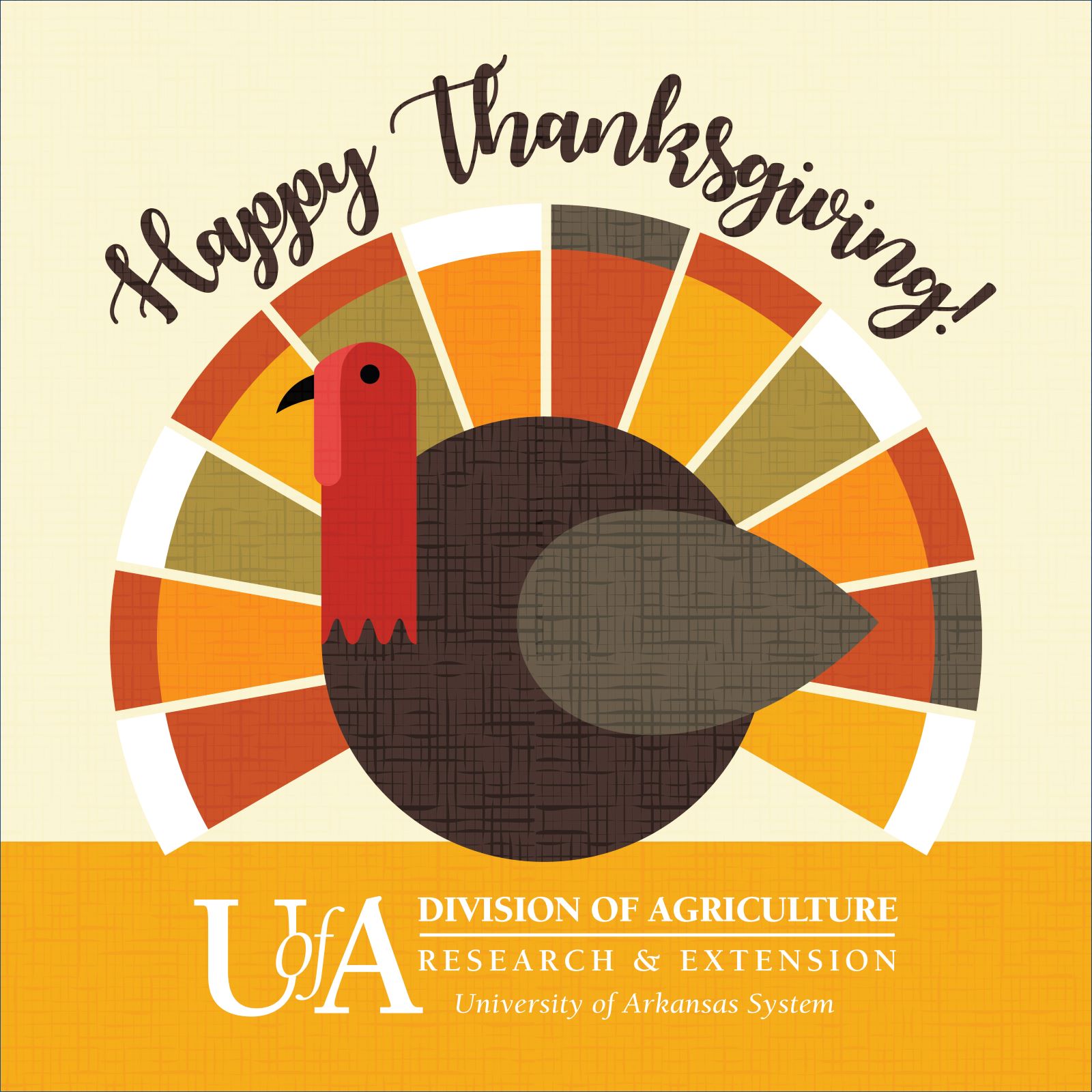HOLIDAYS: Tips for mindful eating this Thanksgiving
By Rebekah Hall
U of A System Division of Agriculture
Nov. 18, 2024
Fast Facts:
- Thanksgiving meal can be stressful for people with concerns about food
- Eat breakfast earlier in the day instead of eating little to ‘save room’ for main meal
- Plan menu in advance, focus on balanced plate and reason for gathering
(591 words)
(Newsrooms: With graphic)
LITTLE ROCK — The Thanksgiving holiday brings family and friends together to celebrate gratitude, but the festivities can be difficult for people with concerns about food or eating. It’s important to approach the day’s meal mindfully and aim for a “middle ground” between overeating or being too restrictive.
Quad Whitson, extension culinary nutrition program associate for the University of Arkansas System Division of Agriculture, said the Thanksgiving holiday can be a challenging day for many.
“Holidays tend to bring out an all-or-nothing mindset towards eating, but I truly believe there is a middle ground,” Whitson said. “This middle ground is a space where both your mind and body can remain healthy. For some people, including those with diet-related medical conditions such as diabetes, this may require some thoughtful planning and preparation — but everyone can make choices to make Thanksgiving Day one to enjoy.”
Whitson suggested people keep the following tips in mind:
- Eat a good breakfast. “Getting into the habit of ‘saving room for a big meal’ can lead to showing up to Thanksgiving dinner overly hungry,” Whitson said. “This can make us be less mindful when eating and we end up eating past the point of comfort, then we’re miserable for the rest of the day.” Instead, Whitson said starting the day with a bowl of oatmeal and fruit or Greek yogurt with granola can help one “make more intentional choices throughout the day.”
- Plan ahead. “Every family has the foods they traditionally prepare on Thanksgiving,” Whitson said. “By keeping those foods in mind, you can better organize your plate to model the USDA’s MyPlate recommendations, which organizes half of the plate with colorful fruits and vegetables and fills the rest with whole grains and protein of your choice.”
- Don’t overthink it. Rather than focusing on individual components of the plate — such as choosing white meat from the turkey instead of dark meat, solely because it has less fat — Whitson said people should focus on the whole plate and keep portion sizes reasonable. “It’s okay to have a few bites of everything, if that’s what you’d like,” he said. “Remember to be mindful during the meal by eating slowly, checking in with yourself about how you feel, and pause to appreciate your food and consider all the moving parts it took to bring the meal together.”
- Save room for dessert. “It is possible to enjoy desserts without going overboard,” Whitson said. “Holiday foods highlight another integral portion of healthy eating, which goes beyond nourishing us physically — cultural traditions and foods nourish the soul and are just as beneficial. Remember, one slice of sweet potato pie isn’t going to make or break the progress you’ve made on your health.”
- Remember why you’re there. “When all things are said and done, remembering why you and your loved ones come together on this day is the most important,” Whitson said. “Take time to enjoy the day and focus on your relationships with the people you care about.”
To further ease anxiety about the meal and to help the body physically, Whitson also suggested people take an after-dinner walk with a friend, family member or pet.
“Participating in low-impact exercise such as walking helps improve digestion,” he said. “Walking after a meal helps stimulate the stomach and intestines, and it helps aid in the movement of food through the digestive system quicker. It may also help with bloating that can occur after eating a meal.”
For more information about food and nutrition, visit the Arkansas Food and Nutrition Resources page on the Cooperative Extension Service website.
To learn about extension programs in Arkansas, contact your local Cooperative Extension Service agent or visit www.uaex.uada.edu. Follow us on X and Instagram at @AR_Extension. To learn more about Division of Agriculture research, visit the Arkansas Agricultural Experiment Station website: https://aaes.uada.edu. Follow on X at @ArkAgResearch. To learn more about the Division of Agriculture, visit https://uada.edu/. Follow us on X at @AgInArk.
About the Division of Agriculture
The University of Arkansas System Division of Agriculture’s mission is to strengthen agriculture, communities, and families by connecting trusted research to the adoption of best practices. Through the Agricultural Experiment Station and the Cooperative Extension Service, the Division of Agriculture conducts research and extension work within the nation’s historic land grant education system.
The Division of Agriculture is one of 20 entities within the University of Arkansas System. It has offices in all 75 counties in Arkansas and faculty on five system campuses.
Pursuant to 7 CFR § 15.3, the University of Arkansas System Division of Agriculture offers all its Extension and Research programs and services (including employment) without regard to race, color, sex, national origin, religion, age, disability, marital or veteran status, genetic information, sexual preference, pregnancy or any other legally protected status, and is an equal opportunity institution.
# # #
Media Contact:
Rebekah Hall
rkhall@uada.edu
@RKHall_
501-671-2061
